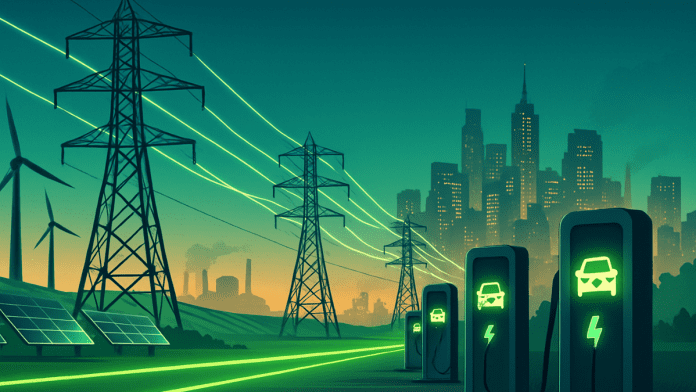🕒 Last updated on August 11, 2025
America’s push toward electric vehicles (EVs) is often seen as a story about batteries, charging stations, and clean energy generation. But a new study shows the real roadblock and the biggest money-making chance — lies somewhere else entirely.
A Massive Opportunity Hidden in Plain Sight
The real problem is the country’s outdated transmission grid. This network of wires, towers, and substations is what carries electricity from where it’s made to where it’s needed. Without it working properly, clean energy from rural wind farms and solar plants can’t reach the cities where most EVs are charged.
Right now, that gap is costing billions. The research shows that grid congestion could wipe out one-third of the emission reductions that EVs could otherwise deliver. Even with plenty of renewable energy available, if it can’t travel through the wires to urban areas, cities will have to keep using dirty fossil fuels to meet demand.
And this is where the huge investment opportunity comes in. Just a small increase in transmission capacity — between 3% and 13% — could remove these bottlenecks and unlock EVs’ full climate benefits. That means targeted, smart upgrades could be worth trillions to the economy.
Why Small Fixes Could Mean Huge Payoffs
America’s power grid isn’t one connected system — it’s actually three separate grids: the Eastern, the Western, and the Texas grids. These operate almost independently, which limits how much electricity they can share. If one region has excess clean energy, it often can’t send it to another area that needs it.
Upgrading connections between these grids could be a game changer. More interconnections would mean power can flow more freely across the country. That would help get renewable energy from rural areas and deserts to busy cities where EV demand is growing fast.
UK to give households near new pylons £2,500 energy bill discount over 10 years
High-voltage transmission lines are another big area for improvement. Federal regulators are already speeding up approvals for new projects. Experts say transmission capacity may need to grow by 150% to 400% to meet national clean energy goals by 2050. But the good news is that even a small percentage boost now could deliver huge returns.
Then there’s the role of modern technology. Smart grids, energy storage systems, and advanced monitoring tools can make the existing grid work much more efficiently. These upgrades help direct electricity to where it’s most needed in real time, avoiding waste and reducing strain on the system.
Where the Money Is Flowing
The U.S. government has already set aside hundreds of billions of dollars for grid improvements through recent infrastructure programs. These funds are designed to attract private investment by lowering risks and making large-scale projects more feasible.
For investors, this means a range of opportunities. Utility companies with strong transmission assets are likely to benefit from federally backed upgrades. Infrastructure funds that focus on energy transmission and grid modernization could see significant growth. Even clean energy funds could become more profitable as grid bottlenecks disappear.
⚡Clean energy crisis — EPA pulls plug on $7 billion “Solar for All” grants
There are also indirect benefits. Areas with better grid access could see rising property values, especially if they become key locations for EV charging stations. More reliable and cleaner electricity supply could also make these regions more attractive for new businesses and industries.
This isn’t about starting from scratch. The study shows that targeted improvements — not a complete rebuild — could make a huge difference. And with both public funding and private capital flowing in, the transformation of America’s grid is set to be one of the biggest infrastructure investments in history.
The electric vehicle shift is moving forward. The question is whether the grid will keep up — and for those with the means to invest, whether they’ll tap into this $2 trillion opportunity before it’s too late.

